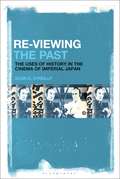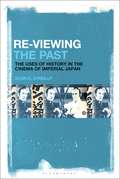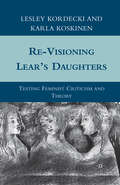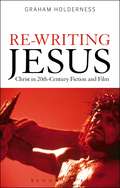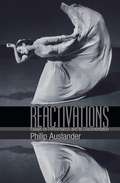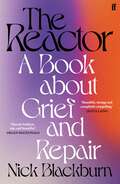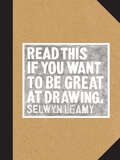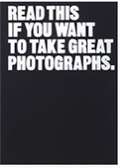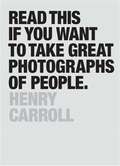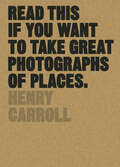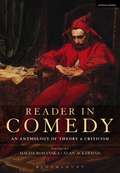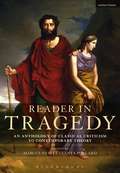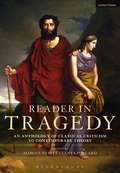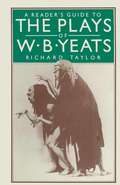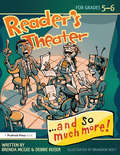- Table View
- List View
The Re-use Atlas: A Designer's Guide Towards a Circular Economy
by Duncan Baker-BrownDo you know how to design for a circular economy? A truly sustainable, circular economy is both a robust and viable option for architecture. Through 24 inspirational case studies, interviews and essays, this book is an accessible and practical guide to how architects can move from a linear economy towards a circular economy. This atlas to sustainable, closed-loop systems takes the reader on a journey through four distinct steps (Recycle, Reuse, Reduce, Circular Economy) that show how they can dramatically reduce the negative impact humans have on the planet. It gives architects the skills and knowledge to navigate through the emerging fields of resource management towards a true Circular Economy. Each step is supplemented with an in-depth interview with an expert who is successfully tacking one or more of the challenges facing all designers today. If we change our behaviour, we enable humanity to work with nature rather than against it. Be part of the change.
The Re-use Atlas: A Designer's Guide Towards a Circular Economy
by Duncan Baker-BrownDo you know how to design for a circular economy? A truly sustainable, circular economy is both a robust and viable option for architecture. Through 24 inspirational case studies, interviews and essays, this book is an accessible and practical guide to how architects can move from a linear economy towards a circular economy. This atlas to sustainable, closed-loop systems takes the reader on a journey through four distinct steps (Recycle, Reuse, Reduce, Circular Economy) that show how they can dramatically reduce the negative impact humans have on the planet. It gives architects the skills and knowledge to navigate through the emerging fields of resource management towards a true Circular Economy. Each step is supplemented with an in-depth interview with an expert who is successfully tacking one or more of the challenges facing all designers today. If we change our behaviour, we enable humanity to work with nature rather than against it. Be part of the change.
Re-Viewing the Past: The Uses of History in the Cinema of Imperial Japan
by Sean D. O’ReillyRe-Viewing the Past: The Uses of History in the Cinema of Imperial Japan analyzes the complicated relationship between history films, audiences, reviewers and censors in Japan for the critically important years from 1925-1945. First contextualizing the history of the popular “Bakumatsu” period (1853-1868), the moment of Japan's emergence as a modern nation, Sean O'Reilly paves the way for a reinterpretation of Japanese pre and postwar cinema. Setting a film in the Bakumatsu period offered 'cultural breathing room' to both filmmakers and viewers, offering a cinematic space where apolitical entertainment and now-forbidden themes like romance still reigned. Some filmmakers-and viewers-even conceived of these films as being a form of resistance against Japan's growing militarism. As comparisons between the popularity of such films versus that of state-sponsored propaganda films show, audiences responded enthusiastically to these glimmers of resistance. O'Reilly argues that we should turn our attention to the much more popular films of the time that were major hits with audiences in order to understand what resonated with wartime spectators, and to speculate about why this might have been the case. Including clips of these rare films, a so-far neglected area of Japanese film history is now firmly situated in context to offer a thought-provoking, multidisciplinary approach.
Re-Viewing the Past: The Uses of History in the Cinema of Imperial Japan
by Sean D. O’ReillyRe-Viewing the Past: The Uses of History in the Cinema of Imperial Japan analyzes the complicated relationship between history films, audiences, reviewers and censors in Japan for the critically important years from 1925-1945. First contextualizing the history of the popular “Bakumatsu” period (1853-1868), the moment of Japan's emergence as a modern nation, Sean O'Reilly paves the way for a reinterpretation of Japanese pre and postwar cinema. Setting a film in the Bakumatsu period offered 'cultural breathing room' to both filmmakers and viewers, offering a cinematic space where apolitical entertainment and now-forbidden themes like romance still reigned. Some filmmakers-and viewers-even conceived of these films as being a form of resistance against Japan's growing militarism. As comparisons between the popularity of such films versus that of state-sponsored propaganda films show, audiences responded enthusiastically to these glimmers of resistance. O'Reilly argues that we should turn our attention to the much more popular films of the time that were major hits with audiences in order to understand what resonated with wartime spectators, and to speculate about why this might have been the case. Including clips of these rare films, a so-far neglected area of Japanese film history is now firmly situated in context to offer a thought-provoking, multidisciplinary approach.
Re-visioning Cellphilming Methodology (Studies in Arts-Based Educational Research #10)
by Claudia Mitchell S. M. Hani Sadati Lisa J. Starr Shannon RoyThis book focuses on cellphilming as a participatory visual methodology in arts-based research and teaching. The book aims to advance critical perspectives—and re-visioning—in relation to the co-production of knowledge through cellphilming. Many of the chapters come out of an international virtual symposium hosted by McGill University in June 2022. It brings together authors working in a variety of interdisciplinary areas and settings including work with Indigenous groups in Canada, girls and women with disabilities in Vietnam, youth in conflict and refugee contexts in Mali, and Sexual and Reproductive Health Rights in Canada, Nigeria, South Africa, and India. Some of the re-visioning addressed in the collection takes up place as we work in new contexts and situations as we are seeing with the idea of ethnographies at a and in relation to COVID-19. The genres, the place of reflexivity, and even the timing of participatory engagement might vary as a result of using virtual platforms necessitated by distancing. Other re-visioning takes place as a result of work with new communities, or new age populations and aspects of intersectionality, looking across work with very young children and older adults. This book contributes to further decolonizing cellphilming methodology to support participatory work in new ways, and with underrepresented groups for whom finding new ways for engagement is key. A special feature of the book is its attention to work with International NGOs. Chapter ‘Cellphones beyond the workshop: Youth researchers owning gender transformative change through participatory visual research in rural India during COVID-19’ is available open access under a Creative Commons Attribution 4.0 International License via link.springer.com.
Re-Visioning Histories in der Gegenwartskunst: Die Arbeiten von Hiwa K und Petrit Halilaj (Image #234)
by Julia WolfGegenwartskunst, die sich mit zeitgeschichtlichen Ereignissen beschäftigt, ist häufig an einer Dekonstruktion und Erweiterung von Geschichte interessiert. Mit Fokus auf Hiwa K und Petrit Halilaj, deren Arbeiten kriegsbedingte Gewalt, Zerstörung, Flucht und Verdrängung thematisieren, untersucht Julia Wolf die Möglichkeiten von Kunst, in Geschichtsschreibung einzugreifen. Die beiden Künstler nutzen erinnerungspolitische, postkoloniale, postmigrantische und verflechtungsgeschichtliche Perspektiven, um vorherrschende Erzählungen einer Gegenwartsbestimmung zu unterziehen. Damit imaginieren sie Geschichte(n) im Sinne der Re-Visioning Histories über die Grenzen des bereits Verständlichen hinaus und zeigen das geschichtspolitische Potenzial zeitgenössischer Kunst auf.
Re-Visioning Lear's Daughters: Testing Feminist Criticism and Theory
by L. Kordecki K. KoskinenKing Lear is believed by many feminists to be irretrievably sexist. Through detailed line readings supported by a wealth of critical commentary, Re-Visioning Lear s Daughters reconceives Goneril, Regan, and Cordelia as full characters, not stereotypes of good and evil. These new feminist interpretations are tested with specific renderings, placing the reader in precise theatrical moments. Through multiple representations, this unique approach demonstrates the elasticity of Shakespeare s text.
Re-Writing Jesus: Christ in 20th-Century Fiction and Film
by Graham HoldernessAt the heart of Christian theology lies a paradox unintelligible to other religions and to secular humanism: that in the person of Jesus, God became man, and suffered on the cross to effect humanity's salvation. In his dual nature as mortal and divinity, and unlike the impassable God of other monotheisms, Christ thus became accessible to artistic representation. Hence the figure of Jesus has haunted and compelled the imagination of artists and writers for 2,000 years. This was never more so than in the 20th Century, in a supposedly secular age, when the Jesus of popular fiction and film became perhaps more familiar than the Christ of the New Testament. In Re-Writing Jesus: Christ in 20th Century Fiction and Film Graham Holderness explores how writers and film-makers have sought to recreate Christ in work as diverse as Anthony Burgess's Man of Nazareth and Jim Crace's Quarantine, to Martin Scorsese's The Last Temptation of Christ and Mel Gibson's Passion of the Christ. These works are set within a longer and broader history of 'Jesus novels' and 'Jesus films', a lineage traced back to Ernest Renan and George Moore, and explored both for their reflections of contemporary Christological debates, and their positive contributions to Christian theology. In its final chapter, the book draws on the insights of this tradition of Christological representation to creatively construct a new life of Christ, an original work of theological fiction that both subsumes the history of the form, and offers a startlingly new perspective on the biography of Christ.
Re-Writing Jesus: Christ In 20th-century Fiction And Film
by Graham HoldernessAt the heart of Christian theology lies a paradox unintelligible to other religions and to secular humanism: that in the person of Jesus, God became man, and suffered on the cross to effect humanity's salvation. In his dual nature as mortal and divinity, and unlike the impassable God of other monotheisms, Christ thus became accessible to artistic representation. Hence the figure of Jesus has haunted and compelled the imagination of artists and writers for 2,000 years. This was never more so than in the 20th Century, in a supposedly secular age, when the Jesus of popular fiction and film became perhaps more familiar than the Christ of the New Testament. In Re-Writing Jesus: Christ in 20th Century Fiction and Film Graham Holderness explores how writers and film-makers have sought to recreate Christ in work as diverse as Anthony Burgess's Man of Nazareth and Jim Crace's Quarantine, to Martin Scorsese's The Last Temptation of Christ and Mel Gibson's Passion of the Christ. These works are set within a longer and broader history of 'Jesus novels' and 'Jesus films', a lineage traced back to Ernest Renan and George Moore, and explored both for their reflections of contemporary Christological debates, and their positive contributions to Christian theology. In its final chapter, the book draws on the insights of this tradition of Christological representation to creatively construct a new life of Christ, an original work of theological fiction that both subsumes the history of the form, and offers a startlingly new perspective on the biography of Christ.
Reaching and Teaching Students with Special Needs Through Art
by Beverly Levett Gerber Doris M. Guay Jane BurnetteThis second edition of Reaching and Teaching Students with Special Needs Through Art is written for art educators, special educators, and those who value the arts for students with special needs. It builds on teachers’ positive responses to the first edition, and now combines over 700 years of the educational experience of arts and special educators who share their art lessons, behavior management strategies, and classroom stories. The revised second edition provides updated chapters addressing students with emotional/behavioral disabilities, learning disabilities, intellectual disabilities, physical disabilities, and visual and hearing impairments.The newly revised second edition includes chapters on students with autism spectrum disorder, preschool students, and students experiencing trauma. All chapters have been updated to include current definitions and language, recommended teaching strategies, art lesson adaptations, behavior management strategies, and references to related chapters. Follow-up activities are provided for further insights into each group of students. A new summary chapter connects how the authors’ collaborations resulted in changes to two professional organizations. Since the first edition, many of the featured authors established the new Division of Visual and Performing Arts Education (DARTS) at the Council for Exceptional Children (CEC) and earlier, formed a new National Art Education Association (NAEA) Interest group—Special Needs in Art Education (SNAE), now Arts in Special Education (ASE).This edition is ideal for preservice arts methods courses and education courses on accessibility and inclusion at the undergraduate and graduate levels. It continues to offer current yet proven best practices for reaching and teaching this ever-important population of students through the arts.
Reaching and Teaching Students with Special Needs Through Art
This second edition of Reaching and Teaching Students with Special Needs Through Art is written for art educators, special educators, and those who value the arts for students with special needs. It builds on teachers’ positive responses to the first edition, and now combines over 700 years of the educational experience of arts and special educators who share their art lessons, behavior management strategies, and classroom stories. The revised second edition provides updated chapters addressing students with emotional/behavioral disabilities, learning disabilities, intellectual disabilities, physical disabilities, and visual and hearing impairments.The newly revised second edition includes chapters on students with autism spectrum disorder, preschool students, and students experiencing trauma. All chapters have been updated to include current definitions and language, recommended teaching strategies, art lesson adaptations, behavior management strategies, and references to related chapters. Follow-up activities are provided for further insights into each group of students. A new summary chapter connects how the authors’ collaborations resulted in changes to two professional organizations. Since the first edition, many of the featured authors established the new Division of Visual and Performing Arts Education (DARTS) at the Council for Exceptional Children (CEC) and earlier, formed a new National Art Education Association (NAEA) Interest group—Special Needs in Art Education (SNAE), now Arts in Special Education (ASE).This edition is ideal for preservice arts methods courses and education courses on accessibility and inclusion at the undergraduate and graduate levels. It continues to offer current yet proven best practices for reaching and teaching this ever-important population of students through the arts.
Reactivations: Essays on Performance and Its Documentation
by Philip AuslanderMost people agree that witnessing a live performance is not the same as seeing it on screen; however, most of the performances we experience are in recorded forms. Some aver that the recorded form of a performance necessarily distorts it or betrays it, focusing on the relationship between the original event and its recorded versions. By contrast, Reactivations focuses on how the audience experiences the performance, as opposed to its documentation. How does a spectator access and experience a performance from its documentation? What is the value of performance documentation? The book treats performance documentation as a specific discursive use of media that arose in the middle of the 20th century alongside such forms of performance as the Happening and that is different, both discursively and as a practice, from traditional theater and dance photography. Philip Auslander explores the phenomenal relationship between the spectator who experiences the performance from the document and the document itself. The document is not merely a secondary iteration of the original event but a vehicle that gives us meaningful access to the performance itself as an artistic work.
The Reactor: A Book about Grief and Repair
by Nick Blackburn'One of the finest accounts of the mysterious workings of grief I have ever read.' Helen MacdonaldI tore the arse of my pyjamas one morning, about a year before he died, and my father sewed it up perfect in a few minutes, just like that. I was looking at them this morning actually, his line of white stitches. It's beautiful really. They've held.'Beautiful, strange and completely compelling.' Olivia Laing'I read it with awe and sorrow.' Fatima BhuttoAfter the sudden death of his father, Nick Blackburn embarks on a singular, labyrinthine journey to understand his loss. How do you create an existence when all you can see is a void?The Reactor is a memoir about absence and creative possibilities, assembled like the pieces of a puzzle. Through philosophy, music, fashion, psychology, art and film, Blackburn travels a vast panorama of ideas and characters to offer an entirely new exploration of grief. This is a book about looking for and finding chain reactions and human connection - a work of enduring fragmentary beauty.
Read This if You Want to Be Great at Drawing: (the Drawing Book For Aspiring Artists Of All Ages And Abilities) (Read This)
by Selwyn LeamyThis book demystifies the art and practice of drawing. Through fifty drawings by great masters past and present, the techniques and ideas behind their master sketches will put you on the path to making your own great drawings. The entries also feature exercises with step-by-step instructions as well as simple diagrams providing further visual explanation to the jargon-free discussion. For aspiring artists of all ages and abilities, Read This if You Want to Be Great at Drawing will motivate and strengthen your drawing talent.
Read This if You Want to Take Great Photographs: (photography Books, Top Photography Tips) (Read This)
by Henry CarrollPhotography is now more popular than ever thanks to the rapid development of digital cameras. Read This If You Want to Take Great Photographs is ideal for this new wave of snapshooters using DSLR, compact system and bridge cameras. It contains no graphs, no techie diagrams and no camera-club jargon. Instead, it inspires readers through iconic images and playful copy, packed with hands-on tips. Split into five sections, the book covers composition, exposure, light, lenses and the art of seeing. Masterpieces by acclaimed photographers – including Henri Cartier-Bresson, Sebastião Salgado, Fay Godwin, Nadav Kander, Daido Moriyama and Martin Parr – serve to illustrate points and encourage readers to try out new ideas. Today’s aspiring photographers want immediacy and see photography as an affordable way of expressing themselves quickly and creatively. This handbook meets their needs, teaching them how to take photographs using professional techniques.
Read This if You Want to Take Great Photographs of People (Read This)
by Henry CarrollNo clichés. No cheese. No camera-club jargon. This straight talking introduction to photographing people is the hotly anticipated follow up to the bestselling Read This if You Want to Take Great Photographs. Ideal for users of any camera with a basic knowledge of a few photo-fundamentals, this book walks you through the essential techniques of photographing people, whether it’s on the street, at home or in the studio. Packed with iconic images by acclaimed photographers, you’ll have the inspiration and knowhow needed to get out there and take great photographs of friends, family and everyone else.50 master photographers including:Richard Avedon, William Klein, Cindy Sherman, Garry Winogrand, Richard Renaldi, William Eggleston, Sebastião Salgado, Henri Cartier-Bresson, August Sander, and Joel Sternfeld
Read This if You Want to Take Great Photographs of Places (Read This)
by Henry CarrollFrom the author of the bestselling Read This If You Want To Take Great Photographs series, this jargon-free introduction covers all aspects of photographing places, including landscapes, cityscapes, architecture, and interiors. Whatever your camera, whatever your interest, whatever your level, this indispensible guide gives you all the essential techniques and demystifies the work of acclaimed photographers. Packed with practical tips and iconic images, this accessible book will arm you with the know-how you need to take meaningful pictures of the places that matter to you most. Featuring 50 master photographers, including Alec Soth, Martin Parr, Robert Adams, Todd Hido, Rut Blees Luxemburg, Julius Shulman, Rinko Kawauchi, Thomas Ruff, Tim Hetherington, and Joel Sternfeld.
Read Write Inc. Phonics: Orange Set 4 Non-fiction 5 Jim's House in 1874 (Read Write Inc Ser.)
by Gill MuntonThese decodable non-fiction titles provide extra practice for children learning to read. Topics include cooking and nature. The clear design introduces children to non-fiction features including captions, labels and diagrams.
Reader in Comedy: An Anthology of Theory and Criticism
by Magda Romanska Alan AckermanThis unique anthology presents a selection of over seventy of the most important historical essays on comedy, ranging from antiquity to the present, divided into historical periods and arranged chronologically. Across its span it traces the development of comic theory, highlighting the relationships between comedy, politics, economics, philosophy, religion, and other arts and genres. Students of literature and theatre will find this collection an invaluable and accessible guide to writing from Plato and Aristotle through to the twenty-first century, in which special attention has been paid to writings since the start of the twentieth century.Reader in Comedy is arranged in five sections, each featuring an introduction providing concise and informed historical and theoretical frameworks for the texts from the period:* Antiquity and the Middle Ages* The Renaissance* Restoration to Romanticism* The Industrial Age* The Twentieth and Early Twenty-First CenturiesAmong the many authors included are: Plato, Aristotle, Horace, Donatus, Dante Alighieri, Erasmus, Trissino, Sir Thomas Elyot, Thomas Wilson, Sir Philip Sidney, Ben Jonson, Battista Guarini, Molière, William Congreve, John Dryden, Henry Fielding, Samuel Johnson, Oliver Goldsmith, Jean Paul Richter, William Hazlitt, Charles Lamb, Søren Kierkegaard, Charles Baudelaire, Bernard Shaw, Mark Twain, Henri Bergson, Constance Rourke, Northrop Frye, Jacques Derrida, Mikhail Bakhtin, Georges Bataille, Simon Critchley and Michael North.As the selection demonstrates, from Plato and Aristotle to Henri Bergson and Sigmund Freud, comedy has attracted the attention of serious thinkers. Bringing together diverse theories of comedy from across the ages, the Reader reveals that, far from being peripheral, comedy speaks to the most pragmatic aspects of human life.
Reader in Comedy: An Anthology of Theory and Criticism
by Magda Romanska Alan AckermanThis unique anthology presents a selection of over seventy of the most important historical essays on comedy, ranging from antiquity to the present, divided into historical periods and arranged chronologically. Across its span it traces the development of comic theory, highlighting the relationships between comedy, politics, economics, philosophy, religion, and other arts and genres. Students of literature and theatre will find this collection an invaluable and accessible guide to writing from Plato and Aristotle through to the twenty-first century, in which special attention has been paid to writings since the start of the twentieth century.Reader in Comedy is arranged in five sections, each featuring an introduction providing concise and informed historical and theoretical frameworks for the texts from the period:* Antiquity and the Middle Ages* The Renaissance* Restoration to Romanticism* The Industrial Age* The Twentieth and Early Twenty-First CenturiesAmong the many authors included are: Plato, Aristotle, Horace, Donatus, Dante Alighieri, Erasmus, Trissino, Sir Thomas Elyot, Thomas Wilson, Sir Philip Sidney, Ben Jonson, Battista Guarini, Molière, William Congreve, John Dryden, Henry Fielding, Samuel Johnson, Oliver Goldsmith, Jean Paul Richter, William Hazlitt, Charles Lamb, Søren Kierkegaard, Charles Baudelaire, Bernard Shaw, Mark Twain, Henri Bergson, Constance Rourke, Northrop Frye, Jacques Derrida, Mikhail Bakhtin, Georges Bataille, Simon Critchley and Michael North.As the selection demonstrates, from Plato and Aristotle to Henri Bergson and Sigmund Freud, comedy has attracted the attention of serious thinkers. Bringing together diverse theories of comedy from across the ages, the Reader reveals that, far from being peripheral, comedy speaks to the most pragmatic aspects of human life.
Reader in Tragedy: An Anthology of Classical Criticism to Contemporary Theory
by Marcus Nevitt Tanya PollardThis unique anthology presents the important historical essays on tragedy, ranging from antiquity to the present, divided into historical periods and arranged chronologically. Across its span, it traces the development of theories and philosophies of tragedy, enabling readers to consider the ways in which different varieties of environmentalist, feminist, leftist and postcolonial thought have transformed the status of tragedy, and the idea of the tragic, for recent generations of artists, critics and thinkers. Students of literature and theatre will find this collection an invaluable and accessible guide to writing from Plato and Aristotle through to Freud, Nietzsche, Schopenhauer and 21st century theorists.Ideas of tragedy and the tragic have been central to the understanding of culture for the past two millennia. Writers and thinkers from Plato through to Martha Nussbaum have analyzed the genre of tragedy to probe the most fundamental of questions about ethics, pleasure and responsibility in the world. Does tragedy demand that we enjoy witnessing the pain of others? Does it suggest that suffering is inevitable? Is human sexuality tragic? Is tragedy even possible in a world of rolling news on a digitally connected planet, where atrocity and trauma from around the globe are matters of daily information? In order to illustrate the different ways that writers have approached the answers to such questions, this Reader collects together a comprehensive selection of canonical writings on tragedy from antiquity to the present day arranged in six sections, each featuring an introduction providing concise and informed historical and theoretical frameworks for the texts.
Reader in Tragedy: An Anthology of Classical Criticism to Contemporary Theory
by Tanya Pollard Marcus NevittThis unique anthology presents the important historical essays on tragedy, ranging from antiquity to the present, divided into historical periods and arranged chronologically. Across its span, it traces the development of theories and philosophies of tragedy, enabling readers to consider the ways in which different varieties of environmentalist, feminist, leftist and postcolonial thought have transformed the status of tragedy, and the idea of the tragic, for recent generations of artists, critics and thinkers. Students of literature and theatre will find this collection an invaluable and accessible guide to writing from Plato and Aristotle through to Freud, Nietzsche, Schopenhauer and 21st century theorists.Ideas of tragedy and the tragic have been central to the understanding of culture for the past two millennia. Writers and thinkers from Plato through to Martha Nussbaum have analyzed the genre of tragedy to probe the most fundamental of questions about ethics, pleasure and responsibility in the world. Does tragedy demand that we enjoy witnessing the pain of others? Does it suggest that suffering is inevitable? Is human sexuality tragic? Is tragedy even possible in a world of rolling news on a digitally connected planet, where atrocity and trauma from around the globe are matters of daily information? In order to illustrate the different ways that writers have approached the answers to such questions, this Reader collects together a comprehensive selection of canonical writings on tragedy from antiquity to the present day arranged in six sections, each featuring an introduction providing concise and informed historical and theoretical frameworks for the texts.
Reader's Theater...and So Much More!: Grades 5-6
by Brenda McGee Debbie Keiser TriskaReader's Theater . . . and So Much More! is written for grades 5-6. This exciting resource contains plays, skits, and independent research activities with an innovative twist for differentiated instruction. This high-interest book of humorous skits and plays is a jumping-off point for research and creativity for students of all ability levels. Each of the reader's theaters comes with suggestions for differentiating and extending the lesson's content. These plays not only provide a legitimate reason for students to reread texts and practice fluency, but they also promote cooperative interaction with peers.Grades 5-6
Reader's Theater...and So Much More!: Grades 5-6
by Brenda McGee Debbie Keiser TriskaReader's Theater . . . and So Much More! is written for grades 5-6. This exciting resource contains plays, skits, and independent research activities with an innovative twist for differentiated instruction. This high-interest book of humorous skits and plays is a jumping-off point for research and creativity for students of all ability levels. Each of the reader's theaters comes with suggestions for differentiating and extending the lesson's content. These plays not only provide a legitimate reason for students to reread texts and practice fluency, but they also promote cooperative interaction with peers.Grades 5-6

